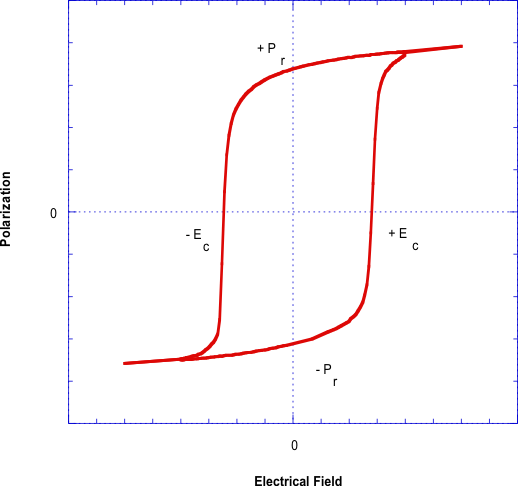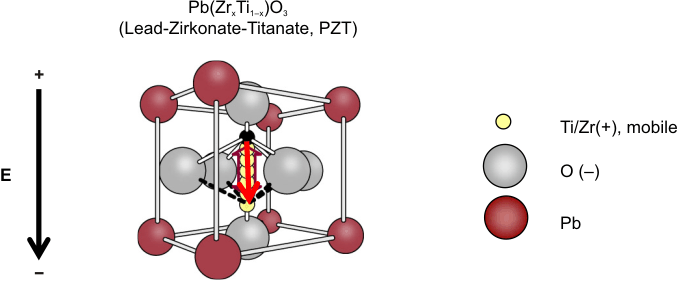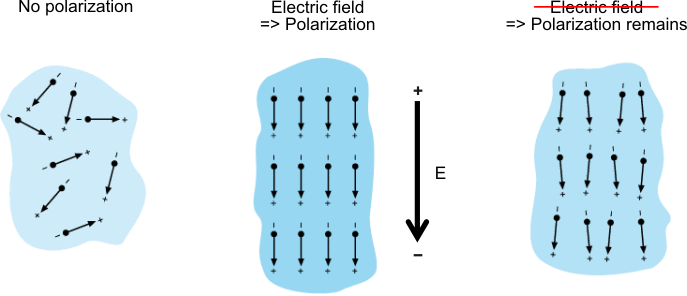SLAA502A July 2011 – September 2023 MSP430FR5720 , MSP430FR5721 , MSP430FR5722 , MSP430FR5723 , MSP430FR5724 , MSP430FR5725 , MSP430FR5726 , MSP430FR5727 , MSP430FR5728 , MSP430FR5729 , MSP430FR5730 , MSP430FR5731 , MSP430FR5732 , MSP430FR5733 , MSP430FR5734 , MSP430FR5735 , MSP430FR5736 , MSP430FR5737 , MSP430FR5738 , MSP430FR5739
1 What is FRAM?
FRAM stands for Ferroelectric Random Access Memory. (Note there are other acronyms for FRAM used by other companies such as F-RAM or FeRAM.)
As the RAM part of the name already suggests, FRAM behaves similarly to DRAM. It allows random access to each individual bit for both read and write. Unlike EEPROM or Flash memory technology, FRAM does not require a special sequence to write data nor does it require a higher programming voltage. But FRAM is non-volatile; that is, it does not "lose" its content when power is removed.
So why is FRAM non-volatile? This is because of the special dielectric material used in the storage capacitor: a ceramic that allows making use of the so-called ferroelectric effect.
The term "ferroelectric" does not mean that the memory contains iron (the chemical element Fe) nor does it imply that the memory can be influenced by magnetic fields. In fact, it is immune to magnetic fields.
 Figure 1-1 Polarization Hysteresis Loop
Figure 1-1 Polarization Hysteresis LoopThe term comes from the hysteresis loop (shown in Figure 1-1) being similar to the magnetic hysteresis loop of iron (Fe). In contrast to the magnetic hysteresis loop, the one in FRAM results from the electrical dipole formed by zirconium (Zr) and oxygen (O) atoms in the ceramic lead-zirkonate-titanate crystal (PZT) used to implement FRAM as shown in Figure 1-2.
 Figure 1-2 Lead-Zirkonate-Titanate Structure
Figure 1-2 Lead-Zirkonate-Titanate StructureApplying an electrical field (E) can polarize the material by "moving" the Zi atom in the structure. But to move the Zi atom from one side (upper in Figure 1-2) to the other side (lower in Figure 1-2) of the O atoms, it must cross the barrier formed by the O atoms. With increasing field strength, the Zi atom gradually moves closer to the O atoms before—at a certain field strength—it suddenly flips to the other side. If a field is then applied from the opposite direction, again the Zi atom would gradually change its position before flipping to the other side. This will happen at the same field strength as before, but with an opposite sign. This behavior results in the electrical field versus polarization hysteresis loop shown in Figure 1-1.
 Figure 1-3 Polarization
Figure 1-3 PolarizationAfter manufacturing, the dipoles formed by the zirconium and oxide atoms are randomly polarized resulting in a net polarization of zero (no polarization). Applying an electric field aligns the dipoles and results in a polarization in the direction defined by the electric field. Because the position of the zirconium atoms within the crystal structure is stable, the polarization remains even after removing the electric field.